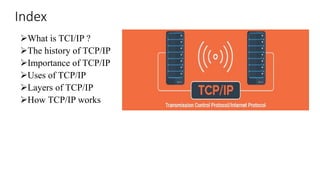TCP/IP Modal
- 2. Index What is TCI/IP ? The history of TCP/IP Importance of TCP/IP Uses of TCP/IP Layers of TCP/IP How TCP/IP works
- 3. What is TCI/IP ? TCP/IP, or the Transmission Control Protocol/Internet Protocol, is a suite of communication protocols used to interconnect network devices on the internet. TCP/IP can also be used as a communications protocol in a private computer network (an intranet or an extranet). The entire Internet Protocol suite,a set of rules and procedures is commonly referred to as TCP/IP.
- 4. The history of TCP/IP The Defence Advanced Research Projects Agency (DSRPA), the research branch of the U.S. Department of Defence, created the TCP/IP model in the 1970s for use in ARPANET, a wide area network that preceded the internet. TCP/IP was originally designed for the Unix operating system, and it has been built into all of the operating systems that came after it. The TCP/IP model and its related protocols are now maintained by the Internet Engineering Task Force.
- 5. TCP/IP is nonproprietary and, as a result, is not controlled by any single company. Therefore, the Internet Protocol suite can be modified easily. It is compatible with all operating systems, so it can communicate with any other system. The Internet Protocol suite is also compatible with all types of computer hardware and networks. TCP/IP is highly scalable and, as a routable protocol, can determine the most efficient path through the network. It is widely used in current internet architecture. Importance of TCP/IP
- 6. Uses of TCP/IP TCP/IP can be used to provide remote login over the network, for interactive file transfer, to deliver email, to deliver webpages over the network and to remotely access a server host's file system. Most broadly, it is used to represent how information changes form as it travels over a network, from the concrete Link layer to the abstract application layer. It details the basic protocols, or methods of communication at each layer as information pass through.
- 8. The application layer provides applications with standardized data exchange. Its protocols include the HTTP, FTP, Post Office Protocol 3 , Simple Mail Transfer Protocol and Simple Network Management Protocol. At the application layer, the payload is the actual application data. The transport layer is responsible for maintaining end-to-end communications across the network. TCP handles communications between hosts and provides flow control, multiplexing and reliability. The transport protocols include TCP and User Datagram Protocol,which is sometimes used instead of TCP for special purposes. The transport layer The application layer:
- 9. •The network layer, also called the internet layer, deals with packets and connects independent networks to transport the packets across network boundaries. •The network layer protocols are the IP and the Internet Control Message Protocol, which is used for error reporting. •The physical layer, also known as the network interface layer or data link layer, consists of protocols that operate only on a link the network component that interconnects nodes or hosts in the network. •The protocols in this lowest layer include Ethernet for local area networks and the Address Resolution Protocol. The network layer: The Link layer:
- 10. How TCP/IP works • TCP/IP uses the Client-server model of communication in which a user or machine (a client) is provided a service (like sending a webpage) by another computer (a server) in the network. • Collectively, the TCP/IP suite of protocols is classified as stateless,which means each client request is considered new because it is unrelated to previous requests. Being stateless frees up network paths so they can be used continuously. • The transport layer itself, however, is stateful. It transmits a single message, and its connection remains in place until all the packets in a message have been received and reassembled at the destination. • The TCP/IP model differs slightly from the seven-layer Open Systems Interconnection (OSI) networking model designed after it. The OSI reference model defines how applications can communicate over a network.
- 11. Thank you .










